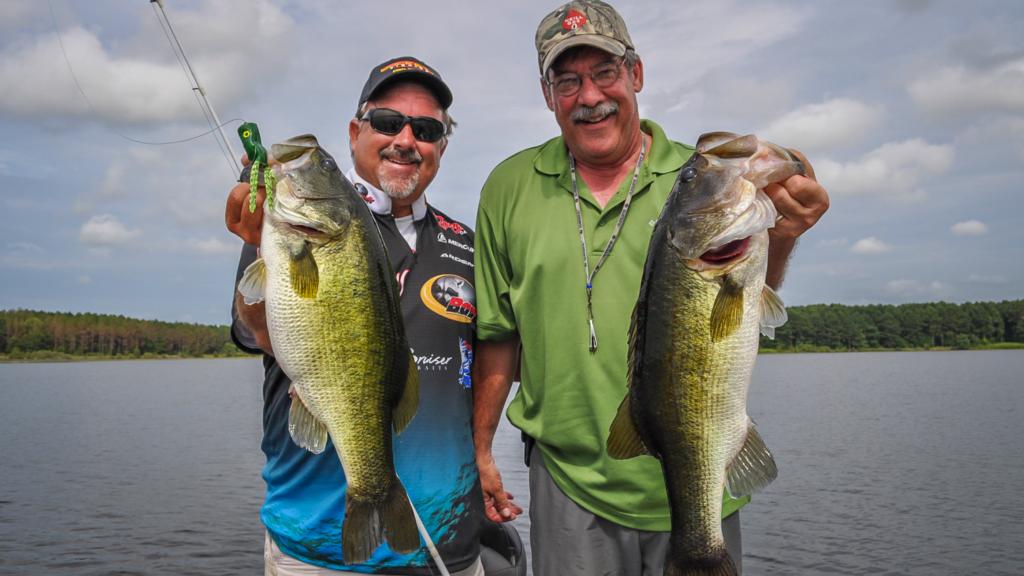Frog fishing 101
Pete Ponds makes frog fishing easy

(Editor’s Note: The writer's opinions and observations expressed here are his own, and do not necessarily reflect or represent the views, policies or positions of FLW.)
People often ask me about what frog I use and when. It’s a good question, because there are many, many frogs available to anglers these days.
The answer depends on the situation you expect to encounter.
Scattered-Cover Frogs
Most of the time I throw a Scum Frog. Its body is very soft, and the hooks are already in the correct position so you don't have to bend them out or in as you do with many others. Both of these factors are very important when it comes to strike-to-catch ratio.
What has to be my favorite frog is the Scum Frog Chugger. I use it to fish brush, milfoil, hydrilla, coontail, lily pads, boat docks, riprap … you get the idea. I use it almost anywhere that there is scattered shallow cover where a normal topwater can’t go.
One of the keys to this bait is the cadence you use when you work it. I like to let the fish tell me whether a twitch-twitch-pause or a twitch-pause-twitch-pause works best. If you pay attention, the fish will let you know.
Heavy-Cover Frogs
The Chugger seems to catch bigger fish than a standard topwater lure. That being said, it is not the “solve-all” for hollow-body frogs. It’s not the best choice when you have thick lily pads or heavy matted grass. For those situations, I like to use a larger, heavier frog with a rattle. I can make longer casts to places that I can't get close to with the boat, and the weight helps make the mat or lily pads move as the frog goes across the top. Otherwise, the fish won’t know it's there.
My top choices here are the BOOYAH Pad Crasher or the Scum Frog Pro Series. Both have smooth bottoms, so they come through the heavy cover or thick mats with ease. I like to hold my rod down with a steady, heavy twitch as I work it, just waiting for that explosion. Most of the time I cover water fast here until I get that key bite.
Walk-the-Frog Choices
When the cover is starting to die in the fall, or as it is just coming in during spring and early summer, the frogs I like best are the Scum Frog Scum Dog Walker and Small Dog. Both have V-shaped bottoms and split rings that make walking the dog easy – just twitch, twitch, twitch, pause and again.
*Editors Note: Here is a short video explaining how to walk a frog.
Colors
As far as colors, I have to giggle a little here. Most of the modern-day “real-looking frogs” have solid colors on the bottom, and the top is designed to lure us fishermen in the store. I like to pay attention to the bait the bass are eating. When shad are present I like to use white or a light color. When I hear frogs doing their thing black is the color. When I hear bream sucking I use green, yellow and other colors. Yet, I also say that if a particular color gives you confidence then more power to you. Confidence is a huge part of our game.
Equipment
The equipment that I use is very important in that strike-to-catch ratio we were talking about earlier. For heavy mats and thick cover I use a Duckett 7-foot, 6-inch, extra-heavy Terex and an Ardent Apex reel with Vicious 65-pound-test braid. In open-water applications I use a Duckett 7-foot, 4-inch, heavy-action Terex and an Ardent Apex reel with Vicious 40-pound-test braid.
4 More Keys to Success
Some very important keys to frog fishing are:
– Pay close attention to any type of movement in a mat, near a piece of cover or along the bank. Many times a fish will give away her location.
– Be sure to hesitate after the strike, and don't set the hook too fast. A good policy is to wait until you see your line moving to swing. It can be challenging, but many times the fish will miss in heavy cover and come back two or three times to get the frog.
– Where you get one strike there are usually more fish in the area. Slow down, and work the area well.
– Pay close attention to the bait. Where you don’t see bait balls or hear bream feeding on bugs, you can quickly eliminate “dead water.”
I hope this has given you some insight on the many choices we have when it comes to “catching a toad” on a hollow-body frog.
Good fishing.
